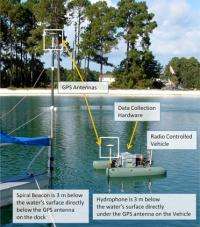Navigating underwater using spiral sound

With the increased use of underwater robotics in both Navy and commercial applications, underwater navigation becomes more and more important. As researchers attempt to make these vehicles smaller and less expensive, simple systems for the navigation of multiple vehicles become important. A research team from Naval Research Laboratory, the University of Washington, and Naval Surface Warfare Center has developed and tested an underwater navigation system that uses a spiral shaped acoustic wave to determine aspect. The single stationary beacon can provide a navigation signal for any number of underwater vehicles.
Navigation by the satellite Global Positioning System (GPS) has become ubiquitous in modern life. Many people have them in our cars and even in our cell phones. These systems can be accurate to within a few meters. Differential GPS (DGPS), which uses a fixed antenna as a reference, can be accurate to within a centimeter. Unfortunately, GPS signals cannot penetrate the water's surface. Thus, various acoustic and inertial techniques have been developed for underwater navigation. Inertial techniques include accelerometers, like those popular in gaming consoles and gyroscopic compasses that can determine position by judging how the vehicle is moving relative to the earth. One acoustic technique available is known as "long-baseline", which uses the distances to fixed sound sources, determined from the time it takes the sound to reach the receiver, to triangulate to the receiver's position. Another popular acoustic technique called "ultra-short baseline" navigation measures the arrival of a single incoming signal using several hydrophones (underwater microphones) positioned on the same vehicle.
The research team's navigation technique differs from the baseline techniques because the signal coming out of the beacon itself varies with aspect, thus only a single hydrophone is required. Consider the pattern of concentric circles made on the surface of a pond after a pebble is tossed in. Each of these peaks and troughs are known as wave fronts and they travel out from a central source at a fixed speed. Under the water's surface, sound waves can easily be made to form circular wave fronts, analogous to the pebble in the pond. The research team developed ways to produce sound with another type of wave front, a spiral wave front, where, instead of concentric circles, there is one continuous spiral shaped line emanating from the source.
These can be stacked with two sources on top of one another to make a navigational beacon. When the team transmited from both sources at the same time, the signal looks like this. The distance between the circular and spiral wave fronts does not change along a particular direction. Thus, if a hydrophone is placed at some position around the beacon, researchers could determine the aspect angle to the beacon by comparing the arrival of the different wave fronts. This navigation technique is also used by aircraft navigation and is called VOR (VHF Omnidirectional Range). However, VOR uses radio signals rather than sound waves.
Based on this concept, the research team had a beacon built by Thomas Howarth at the Naval Undersea Warfare Center in Newport, Rhode Island. To test the accuracy of the beacon, it was attached it to a dock on a pond about 3 meters below the water's surface at the Naval Surface Warfare Center in Panama City, Florida. A remote controlled (RC) pontoon boat was equipped with a hydrophone below the water's surface to determine aspect from the spiral wave front beacon and a GPS antenna above the surface to determine aspect using DGPS (see figure Experimental Setup). The RC boat was driven around a pond and compared the aspect determination from the spiral wave front beacon to the DGPS result. Using the DGPS data the team was able to put the results into a movie showing the position of the RC boat and using arrows to depict the aspect to the beacon using both the spiral wave front beacon results and the GPS results. Although not as good as the DGPS results, the results were quite accurate giving an error between 5 and 15 degrees across all of the data. The team also tested several different signal processing schemes, some of which worked better in different conditions than others.
The biggest advantage of this system over more traditional baseline techniques is simplicity. A single stationary beacon can be used to navigate any number of remote underwater vehicles. The remote vehicles need only have a single hydrophone available, and can even repurpose one from its sonar or acoustic communications system. With future visions of swarms of underwater vehicles, this can be a huge advantage.
The research team consists of Benjamin Dzikowicz, NRL's Acousitcs Division; Brian Hefner, University of Washington, Applied Physics Laboratory; and Robert Leasko, Naval Surface Warfare Center, Panama City, Florida. The Office of Naval Research provided funding for this research.
Provided by Naval Research Laboratory


















